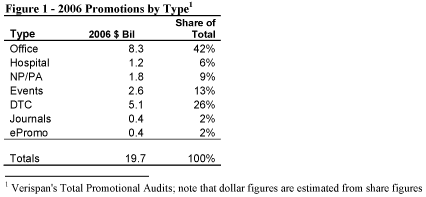Detailing Dominates Pharma Marketing Spending
Detailing continues to account for the lion’s share of drug industry dollars when it comes to marketing drugs, a new study by Verispan shows.
The 2006 Year in Review by Verispan, a provider of healthcare data and analysis, examines trends in various kinds of marketing used by the pharmaceutical industry. It concludes that detailing is still the backbone of drug promotion, accounting for 48 percent of all pharmaceutical marketing dollars.
Spending on the office-based sales force grew by 14 percent from 2003 to 2006, but as a percentage of combined promotional activity, detailing’s share fell from 46 percent to 42 percent.
The pharmaceutical industry invested $19.7 billion in promotional activities in 2006, an increase of 3 percent over 2005, but nowhere near the 18 percent and 20 percent posted for 2003 and 2004, respectively. Detailing in doctors’ offices accounted for the largest share — 42 percent — of promotional activity. Detailing in hospitals accounted for 6 percent. Together that accounts for nearly half of all promotional spending.

Direct-to-consumer (DTC) advertising accounted for the next largest share of dollars, or 26 percent. Trends in DTC and other forms of promotion will be examined in more detail in the next issue of the PDMSN Advisor.
Despite detailing’s foothold over pharmaceutical promotional dollars, a steady reduction in sales representatives has resulted in a 5.9 percent decline in sales calls, from a peak of 97.3 million in 2004 to 91.6 million in 2006. Headcounts have been declining since 2005, when the number of sales reps in the top 40 pharmaceutical companies dropped by 0.1 percent. It fell an additional 2 percent as the result of more substantial layoffs in 2006.
Looking more closely, the data show that the number of actual detailing visits fell faster (by 5.9 percent) than the number of reps (by 2 percent) over the past two years. In a nutshell, that means the reps still out there are less productive. The average rep made about 917 calls per year in 2006, compared with 954 in 2004, which translates into a productivity decline of 3.8 percent. Apparently, not only are pharmaceutical companies cutting their sales forces, but they appear to be getting less out of their reps.
It is too early to draw sweeping conclusions from this. One of the driving factors may be that the industry has moved more toward specialty products such as biologics and oncology drugs. Relative to the big primary care blockbusters, these categories have smaller target audiences and thus would require fewer calls per rep (there are approximately 8,000 oncologists versus more than 50,000 internists). A less benign explanation is growing evidence that physicians are limiting or shutting out access to reps.
Medical journal advertising continues its slow fade. After languishing for over a decade, the $400 million in total spending on medical journal ads in 2006 was almost 20 percent lower than in 1996. It is not a coincidence that 1996 was the last year before the industry embraced DTC in a big way.
Ten years ago, it would have been unthinkable for major product producers to ignore journals entirely, but that is common practice today. For example, many mass market blockbuster products have not introduced new journal ads for five years or more. Journal publishers have long hoped DTC would hit a saturation point that would channel marketing funds back to them, but they’re still waiting.
Journals and other forms of marketing could be the beneficiaries if Congress heeds the growing demand for a ban on DTC during the first year or two of product availability. But publishers beware: even if such a ban gets passed, journals may not be the first place the funds get redirected. — Todd Clark
